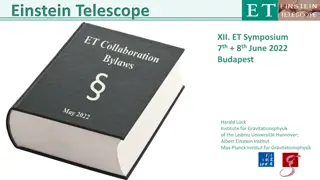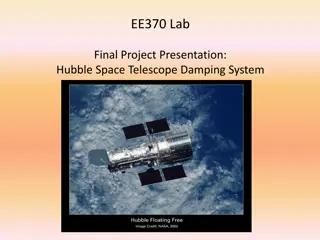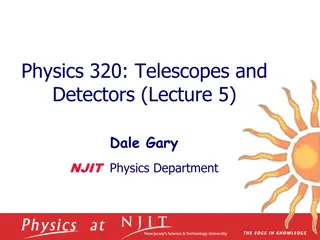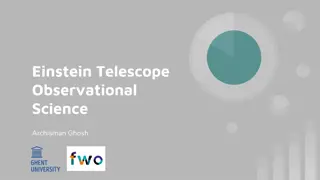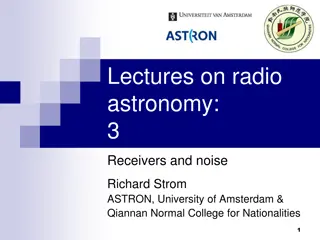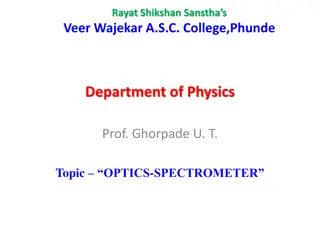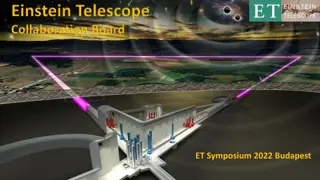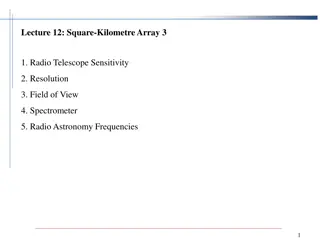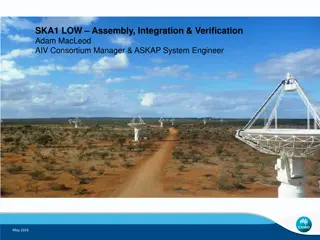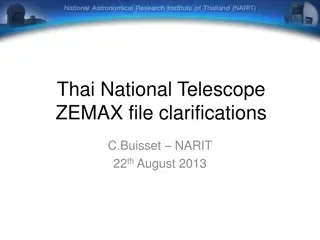Telescope Receivers Analysis
An in-depth analysis of telescope receivers focusing on anisotropy correction, data conversion, and compatibility with common software. Explore the balance function, azimuth angle reception, and beam detection methods. Distributed under GPL 3 for open-source use.
Download Presentation

Please find below an Image/Link to download the presentation.
The content on the website is provided AS IS for your information and personal use only. It may not be sold, licensed, or shared on other websites without obtaining consent from the author.If you encounter any issues during the download, it is possible that the publisher has removed the file from their server.
You are allowed to download the files provided on this website for personal or commercial use, subject to the condition that they are used lawfully. All files are the property of their respective owners.
The content on the website is provided AS IS for your information and personal use only. It may not be sold, licensed, or shared on other websites without obtaining consent from the author.
E N D
Presentation Transcript
OUR WORK: A study about the receiving anisotropy of the telescope Calculation of the maximum angle (theta) Calculation of the receiving balance function of the telescope I.I.S. A Volta Lodi EEE project
Anisotropic receiving of the telescope If the chambers of the telescope were circular, receiving would be isotropic. Because of the rectangular shape of the chambers, receiving from directions similar to that of the long side of the chambers is advantaged if compared to receiving from directions similar to the one of the short side of the chambers. A balance function depending on the azimuth angle of reception (PHI) has been calculated. I.I.S. A Volta Lodi EEE project
How to use the balance function The number of beams counted for each azimuth angle PHI is divided by the value of the function in that direction. If we find, for certain direction, that the number of beams, corrected with the balance function, is higher then the number in the similar directions, we can suppose that a beam source is present in that direction. I.I.S. A Volta Lodi EEE project
Preliminary study about the maximum zenith angle (theta) Theta can not be assumed for all values from 0 to 90 degrees: the maximum value of theta due to the shape of the telescope has been calculated . The maximum theta value is a function of the azimuth angle phi. I.I.S. A Volta Lodi EEE project
Theta max is obtained by heading the track (l) of an imaginary cosmic ray towards an angle of the lower chamber and imagining to lean it in a point that belongs to two opposite sides of the upper chamber; this operation has to be repeated for the four angles of the lower chamber. I.I.S. A Volta Lodi EEE project
(theta) is measured between the vertical axis and the muon track (phi) is measured counter-clockwise between the horizontal axis and the projection of the muon track on the rectangular base of the telescope The measures are the same as the ones of our telescope: x = 82 cm y = 160 cm z = 104 cm I.I.S. A Volta Lodi EEE project
Theta maximums graphic The highest minimum are the directions of the longest sides (0 e 180 ) The lowest minimum are the directions of the shortest sides (90 e 270 ) The four maximum are the directions of the diagonals I.I.S. A Volta Lodi EEE project
Calculation of the reception balance function of the telescope
When a cosmic ray hits the telescope, it has to pass through the surface of all the three chambers in order to be revealed; hence it has to enter from a point that belongs to the surface of the upper chamber and come out from a point that belongs to the lower chamber. Based on the direction of the ray, different shadow zones can be formed ( L shaped or, for some phi values, a simple rectangle) which have to be subtracted from the area of the lower chamber to obtain the area of possible reception. The The ratio between the ratio between the area of the lower chamber where is area of the lower chamber where is possible that the ray hits the telescope possible that the ray hits the telescope and the total area has been calculated. It depends on the direction, identified has been calculated. It depends on the direction, identified with with phi and theta angles. phi and theta angles. and the total area, , I.I.S. A Volta Lodi EEE project
l is the lenght of the muon track P is the projection of the track on the base area x, y, z are the dimensions of the parallelepiped; they consist of numerical data x and y are the dimensions of the shadow zones in which the ray can t hit the chamber; the two shadow zones are overlied and form an L shaped region Area is the part of the base where the ray can hit the chamber x, y and the area depend on phi and theta I.I.S. A Volta Lodi EEE project
The calculation The function of two variables has been calculated with Excel: obviously, it can t be calculated for all the infinite pairs of possible phi and theta values The calculation has been done for phi values form 0 to 360 , delayed by 1 each As far as theta is concerned, the calculation has been done for each value of cos(theta) that differs from 1 (theta = 0 ) to 0,725 (theta = 43,53 ) , which is the maximum angle that can appear, (when the cosmic ray covers the diagonal of the parallelepiped) with a pace of 0,025 I.I.S. A Volta Lodi EEE project
The calculation The pace is uniform in cos(theta) instead of theta because we have supposed that the cosmic beams arrive with the same frequency from all the directions so, all the emisferic surfaces of equal area are crossed by the same number of rays. The emisferic surface has been divided into meridians (one for each degree) and into parallells; the parallels separates the surface in spherical segments with an area= 2. .R.h where R is the radius of the hemisphere and h is the height of the spherical segment: (cos(teta1)-cos(teta2)).R Each spherical segment is divided in 360 equal parts Actually, we can t reach the value of theta = 43,53 for every phi angle: we arrive at a value of maxtheta, which has been calculated separately I.I.S. A Volta Lodi EEE project
The result RECEPTION AREA (PHI, cos(teta)) / TOTAL AREA 1,2 The function obtained is represented by the multiple graphic, drawned for many different values of cos(theta): 1.000, 0.975, 0.950, 0.925, 0,900 ... 1 0,8 areas ratio 0,6 0,4 0,2 0 9 25 41 57 73 89 105121 137 153 169 185 201 217 233 249 265 281 297 313 329 345 1 17 33 49 65 81 97 113 129 145 161 phi 177 193 209 225 241 257 273 289 305 321 337 353 I.I.S. A Volta Lodi EEE project
The balance function Adding the values of every curve, for each azimuth angle, we obtain a function depending only on the azimuth angle phi. The function represents the compensation curve of the telescope s anisotropy, and is drew in the picture. Balance function 0,45 0,4 0,35 0,3 Balance function 0,25 0,2 0,15 0,1 0,05 0 9 25 41 57 73 89 105121 137 153 169 185 201 217 233 249 265 281 297 313 329 345 1 17 33 49 65 81 97 113 129 145 161 177 193 209 225 241 257 273 289 305 321 337 353 PHI I.I.S. A Volta Lodi EEE project
Nnumber of beam versus PHI 160 140 120 Distribution with anisotropy of the chambers 100 Number of beam 80 60 40 20 0 9 25 41 57 73 89 105121 137 153 169 185 201 217 233 249 265 281 297 313 329 345 1 17 33 49 65 81 97 113 129 145 161 177 193 209 225 241 257 273 289 305 321 337 353 PHI Balance function 0,45 0,4 0,35 0,3 Balance function 0,25 f(PHI) 0,2 0,15 0,1 0,05 0 9 25 41 57 73 89 105121 137 153 169 185 201 217 233 249 265 281 297 313 329 345 1 17 33 49 65 81 97 113 129 145 161 177 193 209 225 241 257 273 289 305 321 337 353 PHI Balanced distribution Balanced distribution 400 350 300 Balanced distribution Balanced distribution 250 200 150 100 50 0 I.I.S. A Volta Lodi EEE project 9 25 41 57 73 89 105121 137 153 169 185 201 217 233 249 265 281 297 313 329 345 1 17 33 49 65 81 97 113 129 145 161 177 193 209 225 241 257 273 289 305 321 337 353 PHI
RESULTS We still haven t reliable results because the number of converted files that we can use isn t enough yet to be considered a dependable sample. The analysis about the directions where the rays come from is going to be object of study during the next year. I.I.S. A Volta Lodi EEE project


![get⚡[PDF]❤ The Hubble Space Telescope: From Concept to Success (Springer Praxis](/thumb/21514/get-pdf-the-hubble-space-telescope-from-concept-to-success-springer-praxis.jpg)
